RB Leipzig are coming into the new season looking like a completely new, refreshed side compared to last season. After losing the likes of Joško Gvardiol, Dominik Szoboszlai and Christopher Nkunku, RB Leipzig could be considered much weaker, but they look to have invested their funds wisely. The front four of Timo Werner, Szoboszlai, Nkunku and André Silva has been dismantled, and a new generation of attackers has entered the club.
In this tactical analysis, we will do a deep dive into what RB Leipzig’s attacking unit may look like and the tactics with which Marco Rose will set up. There will be an analysis of the dynamics between each new arrival and a mini scout report of the new attacking signings who arrived this summer.
How Do Leipzig set up
RB Leipzig are likely to continue using the 4-2-2-2 formation that they have been using under Marco Rose. This tactical analysis will focus on the two further attacking lines, as shown in the example below.
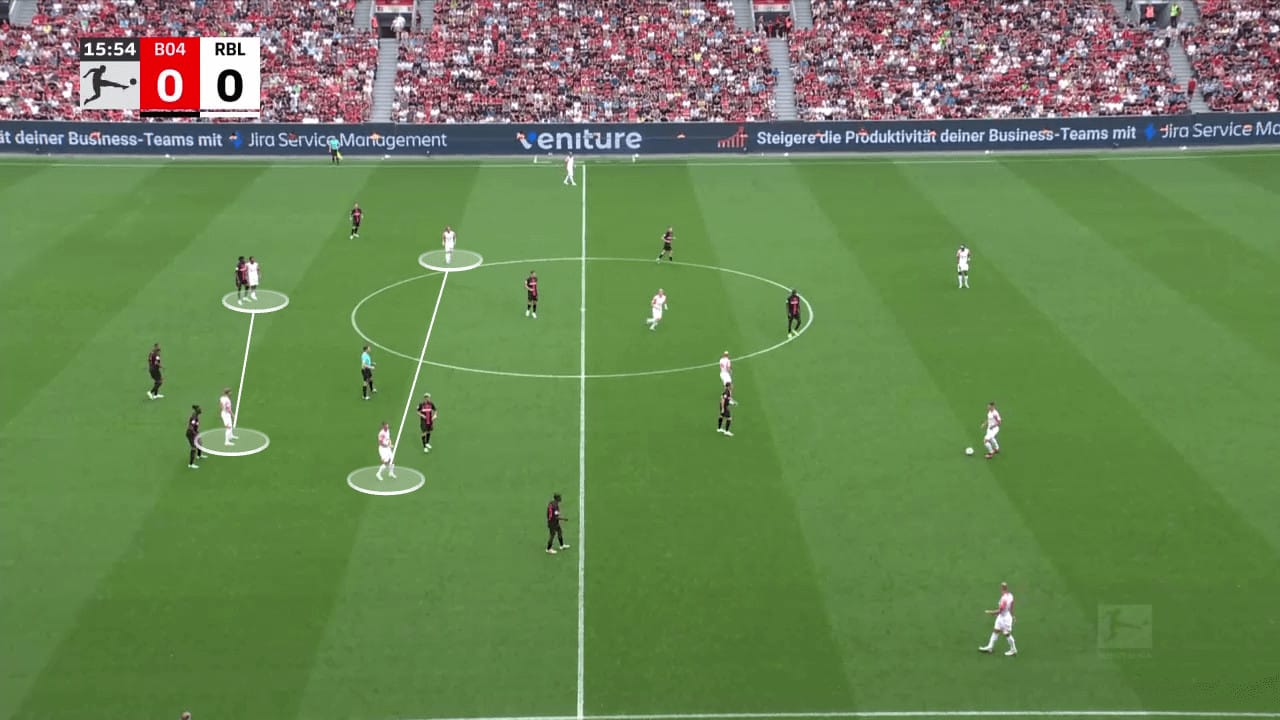
The two attackers closest to the goal are located between each central defender and full-back to pin back the entire defensive line. This then allows the two #10s to have extra time and space to receive the ball. The two deeper players must have excellent technical ability to receive under pressure, turn and release.
The pairing closest to the goal must have excellent pace to attack the space behind the defensive line and help make the most of transitions. RB Leipzig’s attacks are heavily based on these transition moments, so a quick front line is vital to their attacking threat.
In addition, the attacking unit has to be able to hold the ball up during long balls to retain the ball and bring their teammates into play.
We can see in the image below how the defensive line is pinned back by two players, which provides the #10’s to receive the ball with plenty of time and space and drive at the defenders.
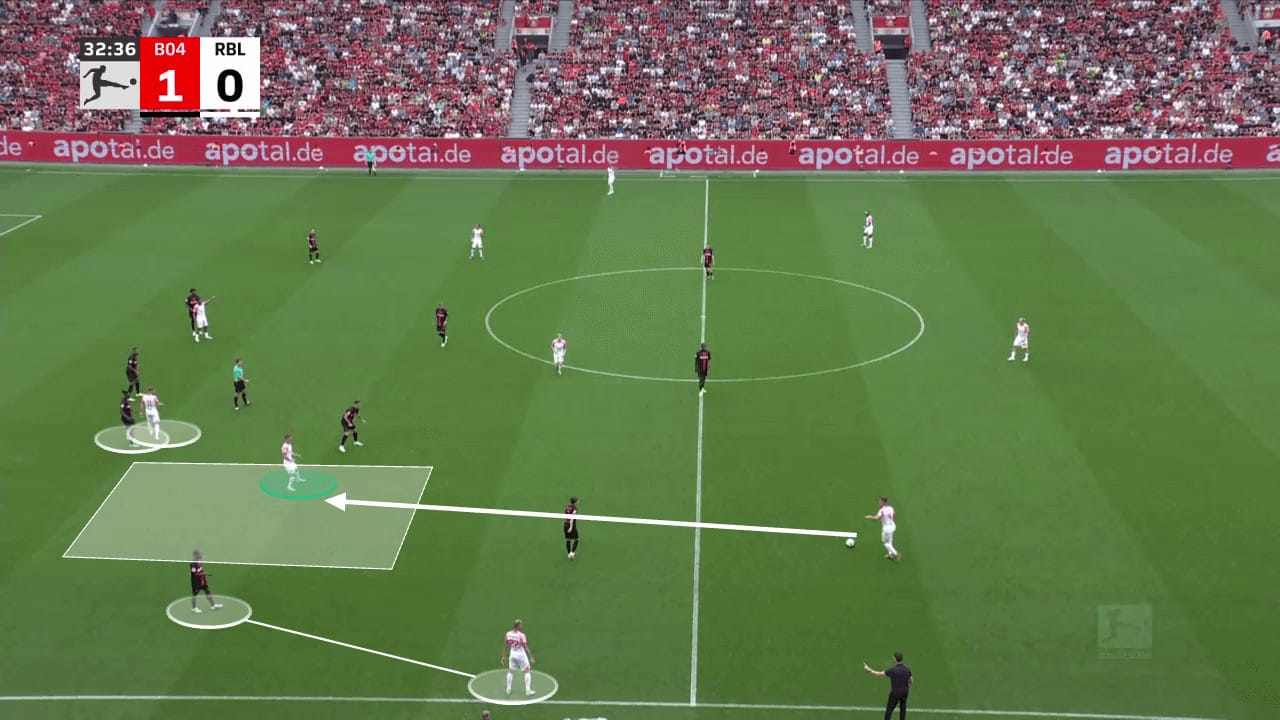
The Attacking Options
Following the earlier explanation of the roles required in Marco Rose’s system, and the busy movement of players both in and out of the club, there are plenty of different possibilities as to how Leipzig can potentially line up.
The deeper pairing of players required to receive the ball in tight areas, between the lines and tasked with chance creation has multiple options.
The newest arrival of loanee Xavi Simons from Paris Saint-Germain is arguably the most influential signing of the window for Leipzig. The young attacking midfielder had set the Eredivisie alight in his first full season in senior football, and his ability to dominate a league with such little experience is only a sign of things to come for the young Dutchman.
In the #10 role, Xavi Simons has the tools to receive the ball under pressure by evading defenders with his quick footwork and having the technical consistency to keep the ball close to his feet.
Being able to turn on both his left and right side, and having an awareness of when to do so, makes him extremely difficult to read, and it is a skill which sets him apart from the rest of his teammates.
In tight spaces, against settled blocks, Simons has the aforementioned technical consistency, which allows him to regularly combine with teammates in close proximity and play passes with the right weight. He periodically looks for one-twos around the box and will look to play reverse passes when the opposition block moves in the opposite direction.
Xavi Simons is unique in his ability to combine neat interior play with pacey, powerful, direct runs to attack spaces in the defensive lines. Something that Leipzig lacked was a player who would be willing to attack space from deeper areas.
Dani Olmo is another interior who is strong at connecting the forward line to the rest of the team through his strong passing, but the ability to attack the box from deep will provide his team with a wider range of ways to score goals.
Fabio Carvalho is another exciting interior player who has displayed his excellent skillset at Fulham and in a limited fashion at Liverpool. The young attacking midfielder is also highly adept inside tight spaces, but his ability to pick out players from wider areas through cutbacks and low crosses across the face of the goal provides Leipzig with yet another threatening method of chance creation.
The front-two pairing is expected to offer a different dynamic to RB Leipzig’s attacks. With the style being transition heavy and the attacks often being played in an extremely direct manner, any member of the attacking line needs the speed to get onto the end of passes played into the spaces behind the defensive line.
Leipzig’s four options include Timo Werner, Benjamin Šeško, Loïs Openda and Yussuf Poulsen for the two attacking spots. All four options can attack space, but each attacker brings different strengths to the unit.
Openda’s arrival brings a much-needed profile of striker for the side. He has blistering pace to take advantage of those big gaps left in transition whilst also possessing the upper body strength to act as a target man and hold the ball up when longer direct passes are played into his feet/body.
Openda can be relied upon to help his team drive up the pitch by retaining possession of the ball and linking play with his teammates while having a reliable record in front of goal. The partnership of Werner and Nkunku lacked the necessary hold-up play, whilst André Silva and Alexander Sørloth couldn’t exploit the spaces behind defensive lines.
Benjamin Šeško similarly can hold the ball up, although he is slightly slower off the mark, perhaps due to his larger, heavier frame. However, once he does get sprinting, he can reach high speeds.
Although he can be seen as lanky, Šeško has swift feet and can manipulate the ball when it might seem like the ball is out of his control. Šeško is also very mobile inside the box, always looking to find space, and has many different finishes he is capable of.
Timo Werner has been a regular in the past 12 months for Leipzig. His pace is unmatched, and what makes him so difficult to stop is his ability to reach high speeds almost instantly after starting the motion.
Although he has had a successful record, Leipzig have felt the need to strengthen up front due to Werner’s technical limitations, which involve his inability to hold the ball up.
Werner often failed to win aerial duels and control low passes, which meant his team were constantly under pressure when facing an organised press; his inconsistency in front of goal was also a cause for concern which has now been improved.
Attacking Methods
Under Marco Rose, a lot of the attacking play centres around possession in the middle third of the pitch. A common theme is attracting a defender to step out of their line, penetrating the gap with a third-man runner.
The attack largely depends on how the pass into an attacker is received. A third-man runner is usually preferred to attack the space by a defender who has stepped up, but there are also moments where the #10 receives the ball between the line whilst the defenders are pinned back.
It is apparent in the image below, where the Leverkusen back line is quite solid and in position, leaving Dani Olmo, located between the defensive and midfield lines, with more space.
While the pass doesn’t quite manage to find its way through, it’s clear to see the spaces which Leipzig attempt to exploit.
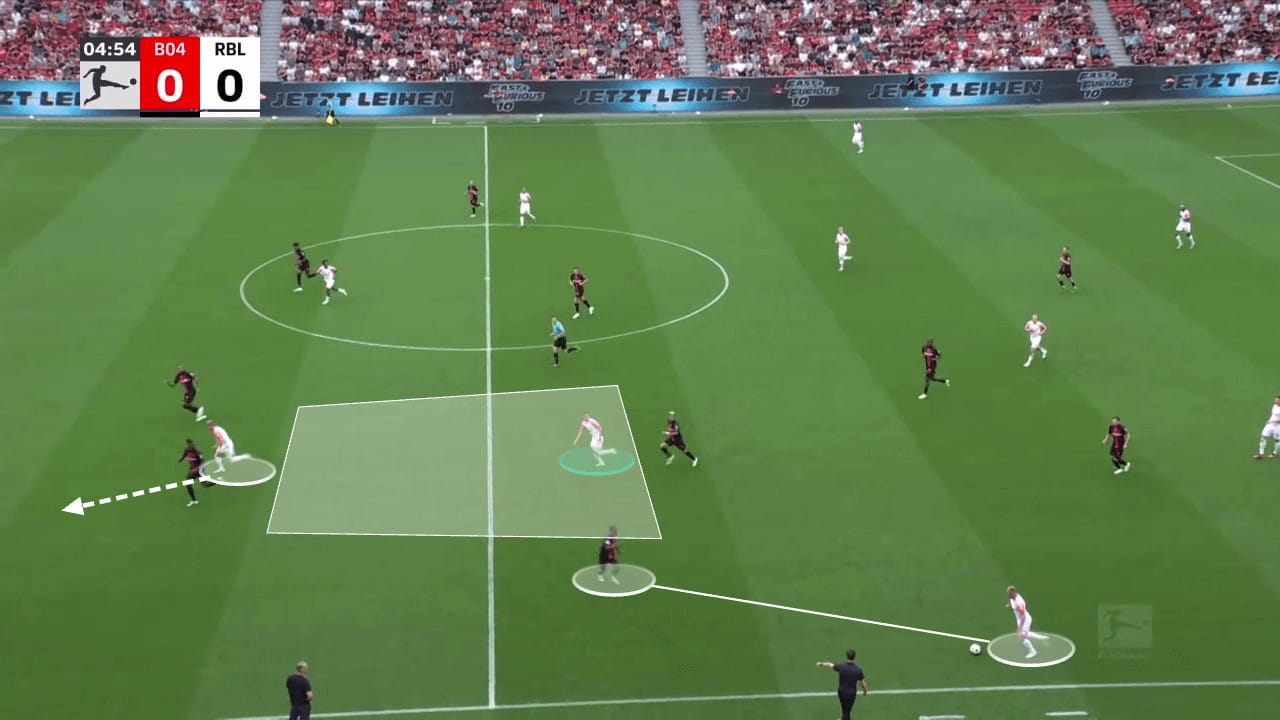
The idea is evident with the third-man runs, where a longer pass is played from a centre-back to a centre-forward. The longer, straighter pass aims to attract pressure from the opposition centre-back to create space in the defensive line.
We can see that Timo Werner receives the ball with a supporting player on either side of him, and there is a runner from deep attacking the space created.
However, Werner’s technical limitations result in a turnover and a goal conceded almost immediately, having just been two passes away from having a chance down the other end.
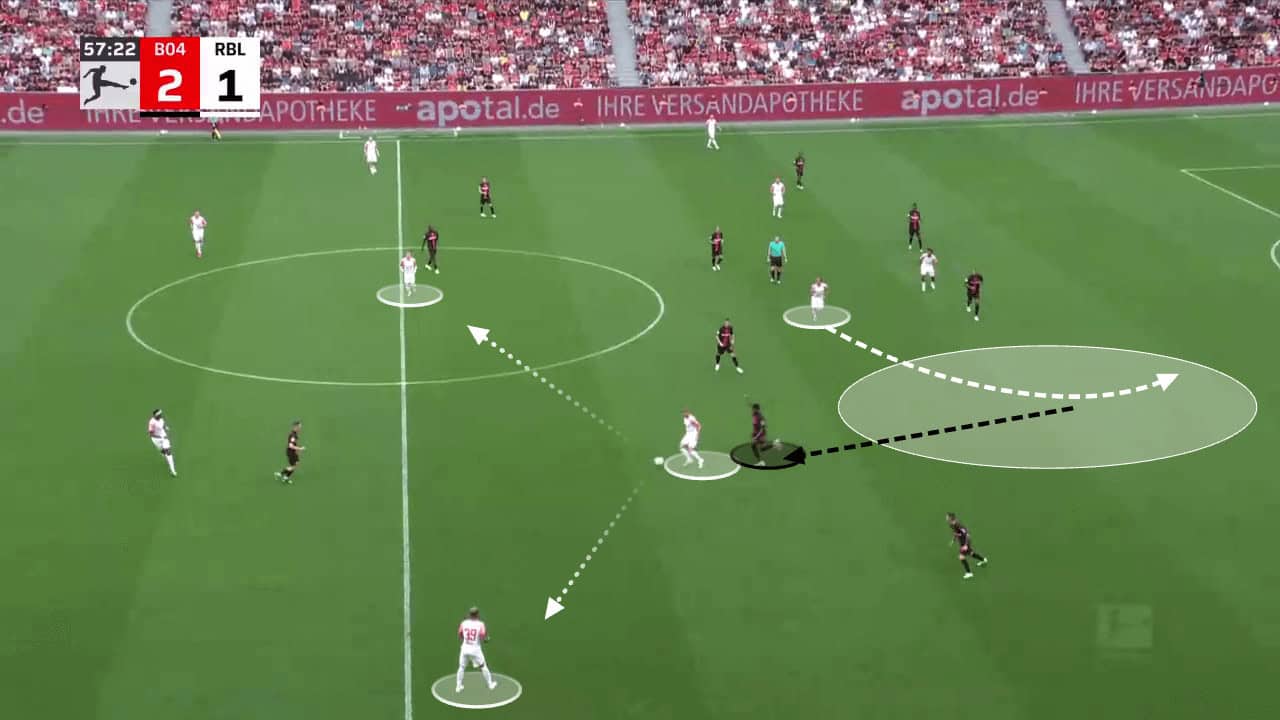
The width in Leipzig’s attacks is usually created by full-backs, with the ball side full-back staying out by the touchline.
When the full-back receives the ball, he encourages the opposition full-back to press him, allowing one of the deeper #10s to attack the space down the channel. The run forward from deeper in the example below shows how movement can create multiple options.
The opposition midfielder tracks the runner, which makes space for one of the double pivot players to receive in case the forward pass isn’t on.
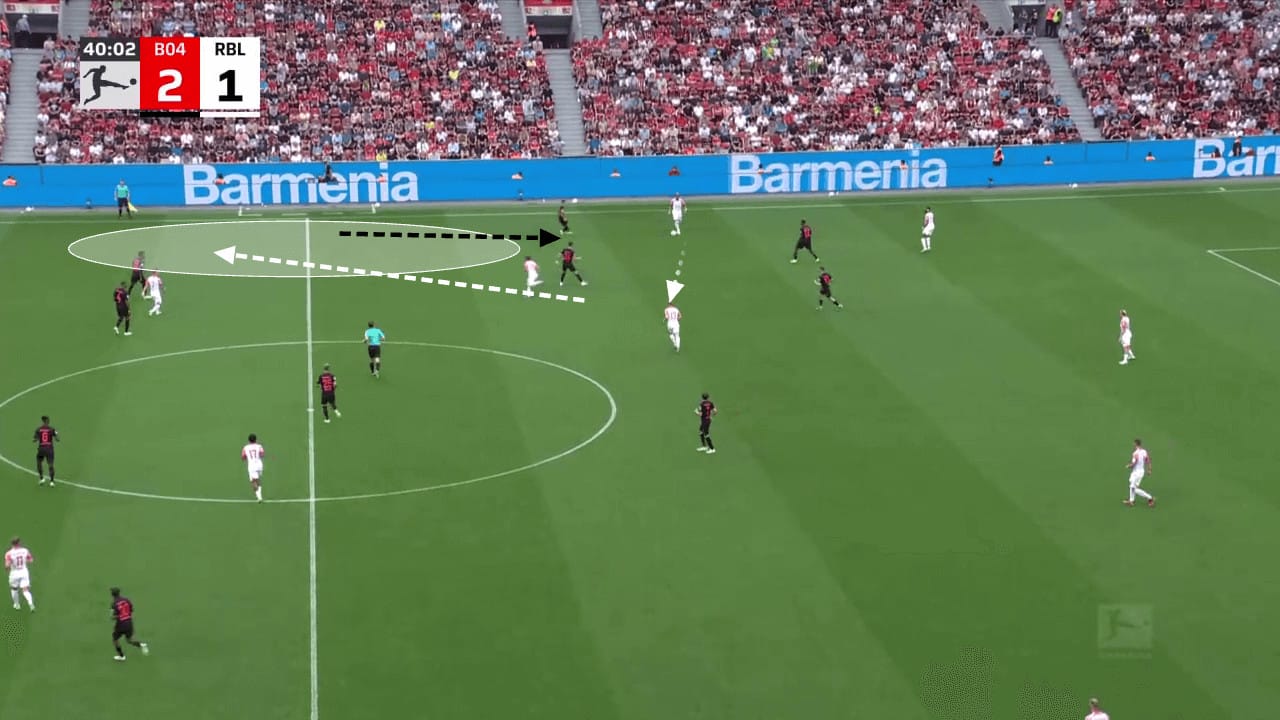
An essential aspect of the new signings has been for each player to have a specific technical base level, which means they can perform certain actions on the ball reliably even if they aren’t suited to them.
The front four can be very fluid, so a striker must be able to receive on the half-turn if they get caught in a deeper area.
Consistent rotations are necessary to keep creating opportunities for a third-man run to be found, and this can only be made possible if each player is comfortable at each phase of the process, whether it is attacking the space, receiving the pass or playing it into the space created.
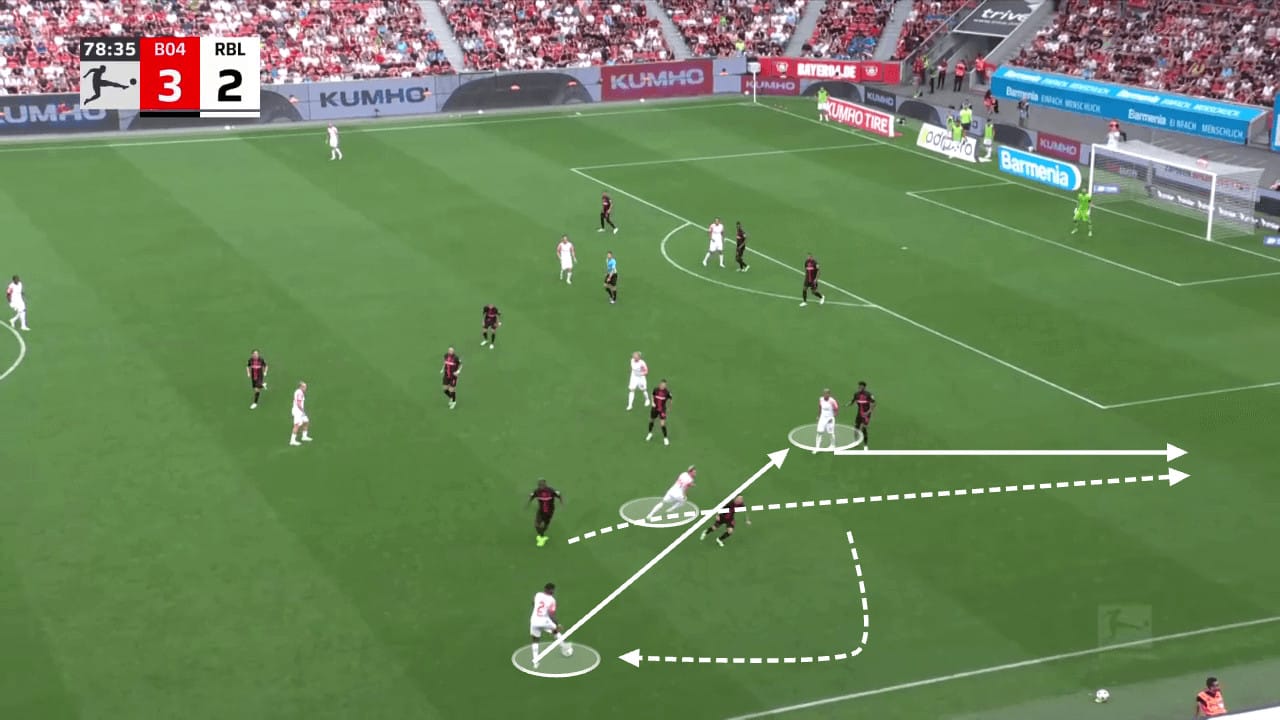
Once they get into the final third, and in general areas where they have bypassed the midfield and are only attacking the defensive line, Leipzig have shown an understanding of how to be effective in front of goal.
We can see in the example below that once the team is running at the defence, they are hard to defend. The front four’s starting positions are all relatively narrow and in close proximity, which then allows for numerous dangerous passing options for the ball carrier.
The example below displays the attacker holding onto the ball and not playing the pass too early for the sake of it. The ball carrier understands to keep the ball until a clear passing option is made.
With numerical superiority for the attacking team, the defenders must choose by either marking the possible passing options, tackling the ball carrier, or leaving someone unmarked.
The attacker must be pressured when near the box to prevent an easy shot from being made, and the attacker understands to hold onto the ball for as long as possible before releasing it in the last possible moment to give his teammate as much space as possible when they eventually received the pass.
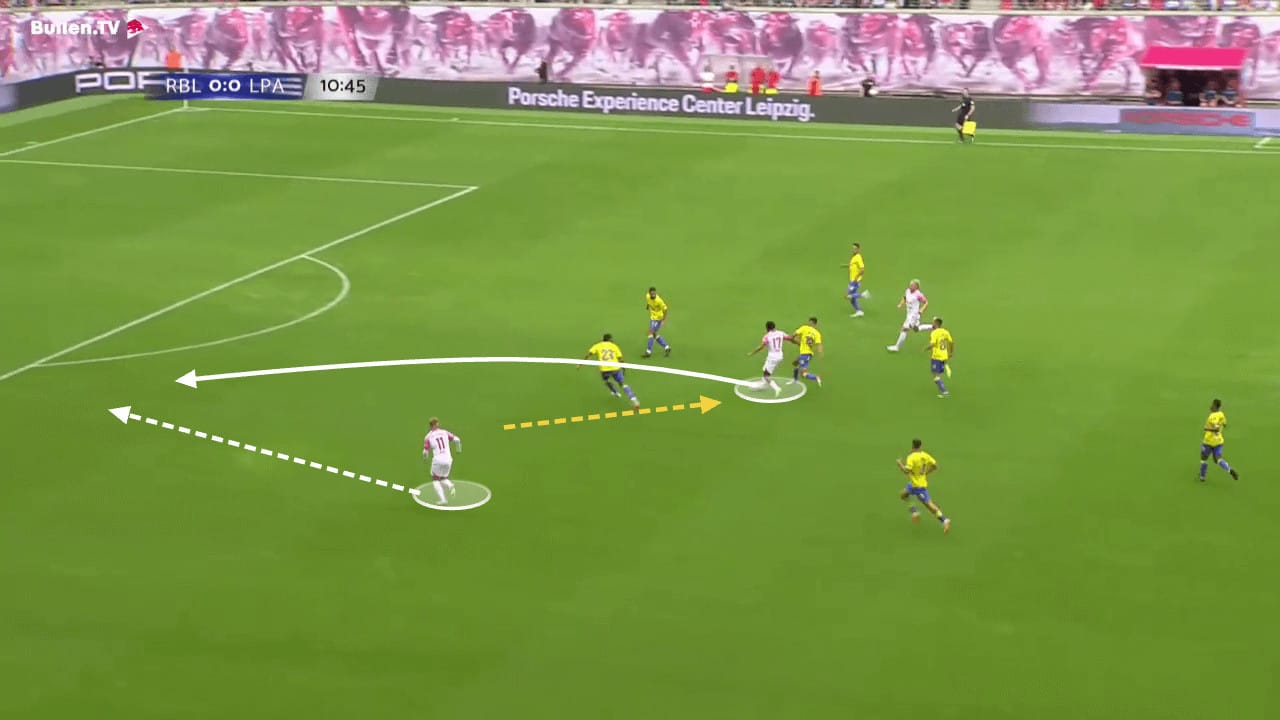
In the wide areas, RB Leipzig are hard to stop with the numerous attackers inside the penalty area and the variety of both crosses and finishes the players are capable of.
With David Raum, like in the example below, Leipzig can fizz crosses across the six-yard box, while Carvalho allows Leipzig to play lofted crosses to the back post and cutbacks to the penalty spot.
Openda has shown the aggressive movement and timing required to attack the space between the defenders and goalkeeper, whilst the likes of Šeško can cause a threat during aerial battles, as well as having a variety of finishes with both feet.
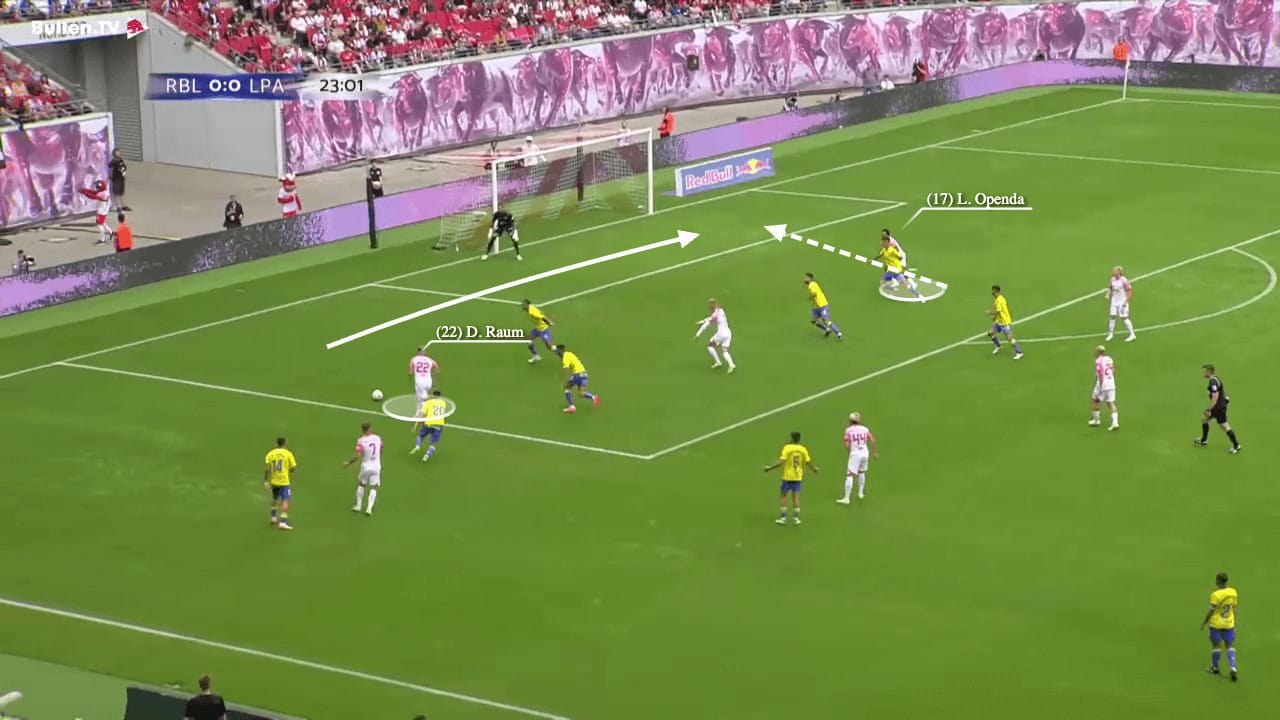
In transition, Leipzig have been tough to stop because of the proximity of the four attackers. With the close distances, Leipzig can make short and quick passing combinations to evade pressure while also having many options attacking the back line.
The example below displays how Leipzig can disperse the players to wide areas to stretch the defensive unit and play on the defender’s back shoulder.
When the pass is about to be made, the attackers can sprint off into the spaces, whilst the defenders aren’t aware of the impending danger.
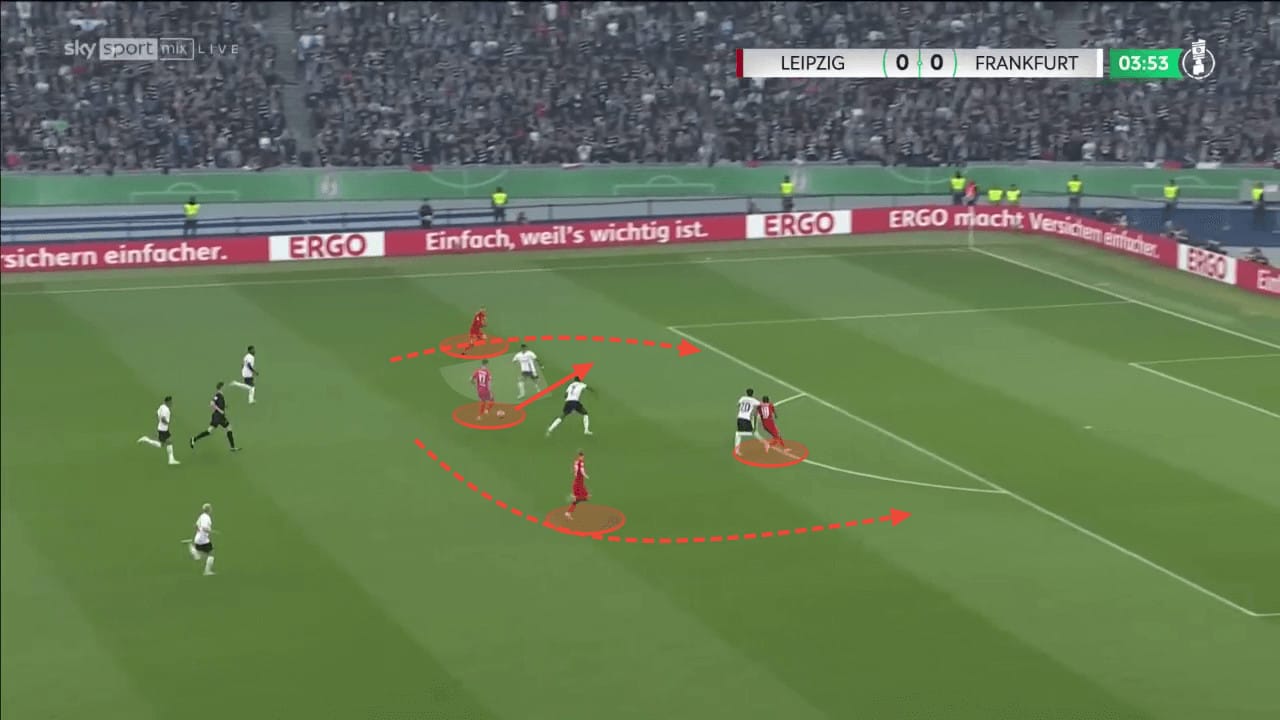
In slightly deeper areas, the likes of Simons and Olmo are able to execute difficult passes with excellent precision to set off the strikers to attack the large open spaces.
The long-range passing ability of the pair means that Leipzig can always be one pass away from being through on goal.
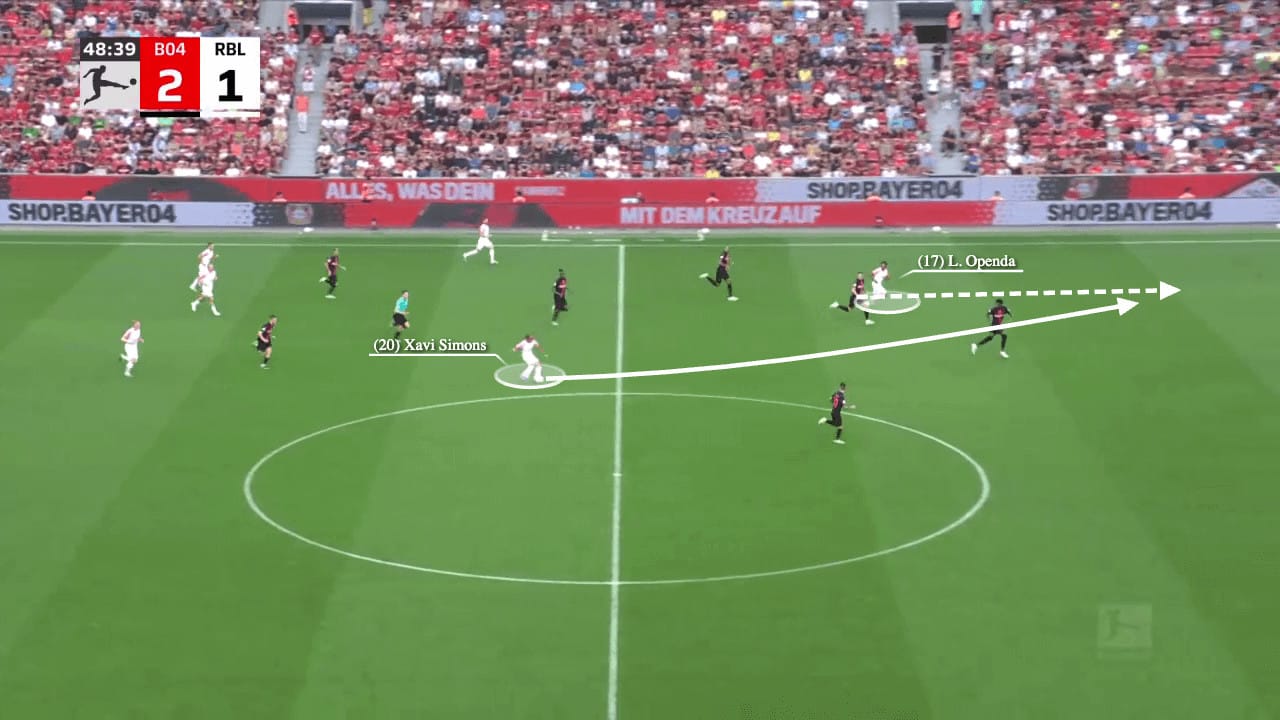
Conclusion
This tactical analysis has detailed the different dynamics RB Leipzig’s attackers will be able to provide, with Marco Rose having the freedom to create many brilliant partnerships.
In transition, Leipzig possess the pace and finishing ability within their squad to finish 1v1 chances reliably. The passing variety also means that these 1v1 opportunities will always appear.
During settled attacks, Leipzig have numerous fantastic crossers of the ball, such as Raum and Carvalho, whether it’s a cutback or a whipped cross, although they can lack the same ability on the right flank at this moment. Almost every attacker is suited to combining tight spaces with an excellent technical floor amongst the squad.
In their front line, they have the power to crash into the box through defenders and the ability to retain possession and bring others into play. There is equal penetration and ability in both the box and deeper areas on both sides of the pitch, although the attacks may be slightly too direct when sometimes unnecessary.






Comments